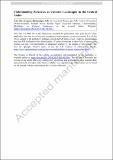Understanding Bofedales as Cultural Landscapes in the Central Andes
Author(s)
White-Nockleby, Caroline; Prieto, Manuel; Yager, Karina; Meneses, Rosa I.
Download13157_2021_1500_ReferencePDF.pdf (923.1Kb)
Publisher Policy
Publisher Policy
Article is made available in accordance with the publisher's policy and may be subject to US copyright law. Please refer to the publisher's site for terms of use.
Terms of use
Metadata
Show full item recordAbstract
Abstract
Bofedales are azonal peat-forming wetlands located in the tropical and subtropical Andes at high altitudes (approximately 3200–5000 m). Motivated by their socio-ecological importance, unique landscape qualities, and increasing vulnerability, scholars have developed a rich research agenda to better understand this ecosystem. We conducted an analysis of the various frameworks used to study bofedales through a systematic review of 119 key academic publications. We observed a range of bofedal naming terminologies, definitions, and descriptions of key threats that sometimes aligned with disciplinary, geographic, or linguistic distinctions between studies. Notably, though the majority of papers employed natural science methods, the social science and multidisciplinary studies were more likely to discuss the role of local communities in helping manage these ecosystems, though many researchers also highlighted the need for further study of these dynamics. This analysis, therefore, demonstrates the need to develop research modalities that are rooted in local contexts and which employ both quantitative and qualitative methods to investigate and elucidate the complex human-environment dynamics that characterize these ecosystems. By documenting, we aim to support more robust research collaborations and to inform the development of research and conservation agendas that effectively support these landscapes and the myriad socio-ecological services they provide.
Date issued
2021-10-27Department
Massachusetts Institute of Technology. Program in History, Anthropology, and Science, Technology, and SocietyPublisher
Springer Netherlands
Citation
Wetlands. 2021 Oct 27;41(8):102
Version: Author's final manuscript